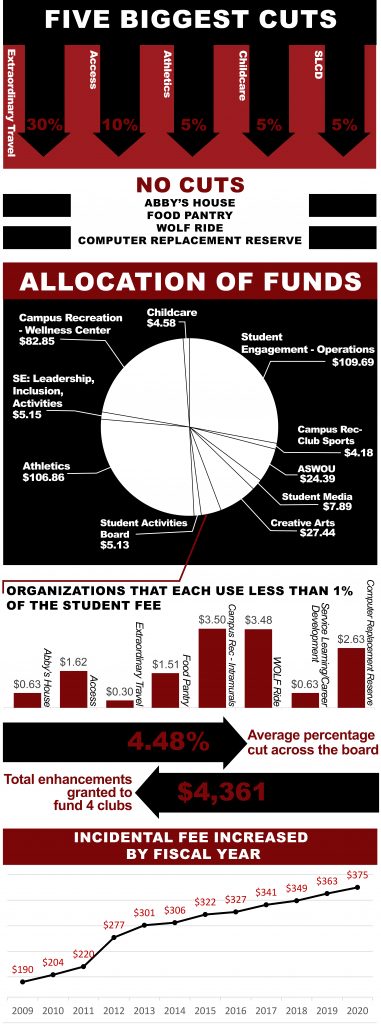
Bailey Thompson | News Editor
When students receive their bills from the university each term, there is a charge entitled “incidental fees” that appears.
According to Western’s webpage, every student who is enrolled at the university for at least 12 credits is required to pay an incidental fee, and this fee is lessened for students who are only enrolled part-time.
While this fee may seem random and frustrating for those who don’t understand its purpose, it is actually something that students can have a say in creating.
For the 2019-2020 school year, the Incidental Fee Committee met on Feb. 15 to determine the preliminary budget for this fee: $375 per term per full-time student, a $12 increase from the 2018-2019 academic year.
Rachel Rhodes, a senior communications major and one of the seven members of the IFC, shared what the purpose of the IFC is at Western.
“We do a review of the budget proposed from all the department heads. And then we decide where the money should go,” said Rhodes.
When looking at the budgets for different organizations by various department heads, Rhodes also shared that there are two different types of budgets that can be proposed.
“There’s their operating budget, and then they can ask for enhancements… outside projects, an extra travel trip, an upgrade to their building, whatever that is for them,” said Rhodes.
With the 2019-2020 IFC budget in particular, Rhodes shared that there was a significant outside voice who helped to determine how much money would be spent: President Rex Fuller.
“We were actually asked by the president not to up the fee more than five percent, and he said that if it was up more than five percent than he wouldn’t approve it. So that was our goal,” said Rhodes.
Having constructed their preliminary budget, Rhodes also noted that people who look over the spending plan may notice significant cuts.
“We cut almost every budget operationally, and that’s because the inflation was so much that, if we fully funded everyone, the fee would have gone up way more,” said Rhodes. “I think becoming the most affordable school in Oregon means you have to make cuts that scare people — like cuts to ASWOU or cuts to athletics — cuts to areas that people might question or that people might not like, but we had to make some hard decisions.”
In addition to the rising costs for both building operations and student workers, due to an increasing minimum wage, Rhodes noted another cause for the fee’s increase.
“It’s a rough subject to talk about right now, but enrollment is down,” said Rhodes. “So, we’re looking at ways to bring in more students, but it’s hard for the same number of students to pay for what more students paid for last year.”
In looking at the new funding sources that they approved for the upcoming year, Rhodes stated that IFC was very selective in their enhancements.
“We wanted to be mindful that we’re cutting operational budgets but we’re giving other organizations money to enhance their programs,” said Rhodes. “So we granted some enhancements to new clubs … because we wanted to help foster those new clubs.”
Having decided the preliminary budget, the next step for the IFC is to host hearings so that members of the community could advocate for programs that are important to them. With this process ahead, Rhodes encouraged all students to make their voices heard so that it will not merely be those directly benefitting from a certain fund who are making their voices heard.
The two open hearings will be held on Thursday, Feb. 21 at 6 p.m. in the Pacific Room of the Werner University Center, and Friday, Feb. 22 at 2 p.m. in RWEC 101. After these hearings, the IFC will present their budget to the ASWOU Senate, the Board of Trustees and President Rex Fuller before it can be finalized.
Students can also voice their opinions through a survey at wou.edu/ifc/news.
Contact the author at howlnews@wou.edu
Infograph by Brittany Figueroa

